英语口语教学法文献综述
英语口语文献综述范文模板大全
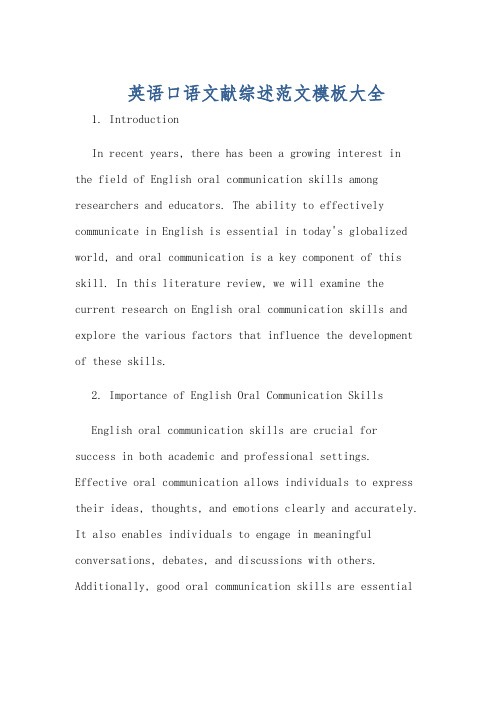
英语口语文献综述范文模板大全1. IntroductionIn recent years, there has been a growing interest in the field of English oral communication skills among researchers and educators. The ability to effectively communicate in English is essential in today's globalized world, and oral communication is a key component of this skill. In this literature review, we will examine the current research on English oral communication skills and explore the various factors that influence the development of these skills.2. Importance of English Oral Communication SkillsEnglish oral communication skills are crucial for success in both academic and professional settings. Effective oral communication allows individuals to express their ideas, thoughts, and emotions clearly and accurately. It also enables individuals to engage in meaningful conversations, debates, and discussions with others. Additionally, good oral communication skills are essentialfor building relationships, collaborating with others, and resolving conflicts.3. Factors Influencing English Oral Communication SkillsThere are various factors that can influence the development of English oral communication skills. These factors include individual characteristics (such as motivation, self-confidence, and language proficiency), social factors (such as cultural norms and communication styles), and contextual factors (such as the learning environment and teaching methods). Researchers have found that a combination of these factors can significantly impact an individual's ability to communicate effectively in English.4. Strategies for Improving English Oral Communication SkillsThere are several strategies that can help individuals improve their English oral communication skills. These strategies include practicing speaking regularly, engaging in conversations with native speakers, listening to English audio materials, watching English videos, and participating in language exchange programs. Additionally, takinglanguage courses, attending workshops, and receiving feedback from peers and teachers can also be beneficial in enhancing oral communication skills.5. Challenges in Developing English Oral Communication SkillsDespite the importance of English oral communication skills, many individuals face challenges in developingthese skills. Some common challenges include fear of speaking in front of others, lack of vocabulary and grammar knowledge, difficulties in understanding accents and intonation, and cultural differences in communication styles. Overcoming these challenges requires patience, practice, and perseverance.6. ConclusionIn conclusion, English oral communication skills are essential for success in today's globalized world. By understanding the factors that influence the development of these skills, implementing effective strategies for improvement, and overcoming challenges, individuals can enhance their ability to communicate effectively in English. Continued research in this area is necessary to furtherexplore the complexities of oral communication and to develop innovative approaches for enhancing these skills.。
英语口语文献综述范文模板

英语口语文献综述范文模板**Exploration and Application of English Speaking Literature Review Template****Abstract**In the academic realm, literature reviews serve as a crucial bridge between past research and current understanding. This article presents an exploration of the English speaking literature review template, its importance in the research process, and its application in various academic contexts. We delve into the structure, key elements, and best practices for crafting an effective literature review, focusing on the English language perspective.**Introduction**Conducting a literature review is an essential step in any research project, as it allows scholars to gain a comprehensive understanding of the existing knowledge in a particular field. In the field of English speaking,literature reviews are particularly crucial as they help researchers identify gaps in the literature, understand the evolution of ideas, and establish the context for their own work. The aim of this article is to provide a comprehensive template for conducting English speaking literature reviews, guiding researchers through the process and highlightingkey considerations.**The Importance of English Speaking LiteratureReviews**English speaking literature reviews play a pivotal role in the academic community. They not only summarize and synthesize existing research but also provide a critical analysis of the strengths and weaknesses of those studies. By conducting a literature review, researchers can ensure that their work is rooted in a solid foundation of knowledge, avoiding duplication and building upon the workof others. Furthermore, literature reviews help establish the research gap, identifying areas where further investigation is needed, thus guiding future research directions.**Structure of the English Speaking Literature Review Template**The English speaking literature review template follows a structured format, ensuring that all relevant information is included and organized in a logical manner. The template typically consists of the following sections:1. **Introduction**: This section briefly introduces the topic of the literature review, outlining the purpose, scope, and research questions. It also provides a background on the importance of the topic and its relevance to the field of English speaking.2. **Methodology**: Here, the researcher describes the methods used to collect and analyze the literature. This includes the search strategy, selection criteria, and any specific analytical tools or frameworks employed.3. **Literature Overview**: This section presents a comprehensive overview of the existing literature, summarizing the key findings and arguments made by previous studies. It aims to provide a broad understanding of the topic and its historical development.4. **Critical Analysis**: In this section, the researcher critically evaluates the literature, identifying strengthsand weaknesses, gaps in research, and areas of consensus or disagreement among scholars. This analysis helps to shape the research agenda and identify areas for further exploration. 5. **Conclusion**: The conclusion section summarizes the main findings of the literature review, highlights the research gap, and suggests directions for future research. It also reaffirms the significance of the topic and its potential to contribute to the field of English speaking.**Best Practices for Crafting an Effective English Speaking Literature Review**When crafting an effective English speaking literature review, it is important to follow certain best practices. These include:* **Clear and Concise Writing**: Literature reviews should be written in a clear, concise, and coherent manner, ensuring that the reader can easily follow the arguments and understand the key points. * **Critical Thinking and Analysis**: Literature reviews should involve critical thinking and analysis, going beyond a mere summary of existing studies. Researchers should evaluate the qualityof the literature, identify gaps in research, and make recommendations for future work. * **Use of Reliable Sources**: It is crucial to rely on reliable and peer-reviewed sources when conducting a literature review. This ensures that the information presented is accurate, credible, and relevant to the field of English speaking. ***Organized Structure**: A well-structured literaturereview helps the reader navigate through the content easily. Organizing the review by themes, subtopics, orchronological order can enhance readability and comprehension. * **Focus on the Topic**: While discussingthe literature, it is important to stay focused on thetopic of the review. Avoid straying into unrelated areas or tangents that do not contribute to the overall objective of the review.**Conclusion**The English speaking literature review template serves as a valuable tool for researchers seeking to synthesizeand analyze existing knowledge in the field. By followingthe structure and best practices outlined in this article, researchers can craft effective literature reviews thatcontribute to the advancement of knowledge and guide future research directions. The template not only facilitates the organization and presentation of information but also promotes critical thinking and analysis, essential skillsfor any researcher working in the field of English speaking. **中文内容****英语口语文献综述范文模板的探索与应用****摘要**在学术领域,文献综述是连接过去研究与当前理解的重要桥梁。
国内外关于小学英语口语教学的文献研究.doc
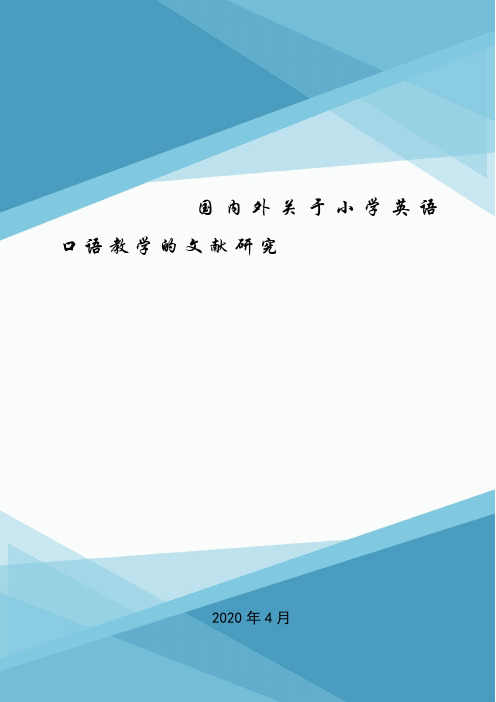
国内外关于小学英语口语教学的文献研究2020年4月国内外关于小学英语口语教学的文献研究本文关键词:英语口语,文献,国内外,小学,教学国内外关于小学英语口语教学的文献研究本文简介:本篇论文目录导航:【题目】小学生英语口语能力提升研究【第一章第二章】国内外关于小学英语口语教学的文献研究【第三章】小学英语口语教学的理论基础【第四章】小学英语口语教学现状调查研究【第五章】小学英语口语教学技巧及技巧采用所遵循的原则【结论/】小学英语口语训练方法探析结论与1引言国内外关于小学英语口语教学的文献研究本文内容:本篇论文目录导航:【题目】小学生英语口语能力提升研究【第一章第二章】国内外关于小学英语口语教学的文献研究【第三章】小学英语口语教学的理论基础【第四章】小学英语口语教学现状调查研究【第五章】小学英语口语教学技巧及技巧采用所遵循的原则【结论/】小学英语口语训练方法探析结论与 1 引言1.1 选题背景科学技术的突飞猛进,全球经济一体化的发展和信息时代的到来,英语作为国际通用语言的地位日渐突出。
截止目前,以英语为官方语言的国家已超过七十个,而且这个数字还在增加。
随着中国改革开放的不断深入,中国与世界各国的交流与合作日益密切,中国对英语人才尤其是口语流利者的需求超过了历史的任一阶段,已把能否用英语与外国人熟练地交流作为人才衡量标准之一。
家长们也认识到英语的重要性,他们认为孩子如果掌握了英语,有助于孩子将来获得教育优势和工作优势,他们甚至还认为孩子越早学习英语越好,因此越来越多的儿童很小就开始了英语学习之旅。
近现代研究也证明,青春期以前是语言学习的关键期,小学生的心理特征和生理特点在外语学习方面占有相当的优势,尤其在语音方面。
由于我国国情的原因,绝大多数小学都是从小学三年级才开设英语课的,而且一周只有三节课,多数又是大班教学,很显然在每节课只有40 分钟的情况下就不能保证每个学生都有足够的口语操练时间,不利于新目标中提及的"面向全体学生" 的学生的口语发展,长期以往,降低了对口语练习的热情,兴趣和信心也渐渐消失。
如何提高中学英语口语教学文献综述
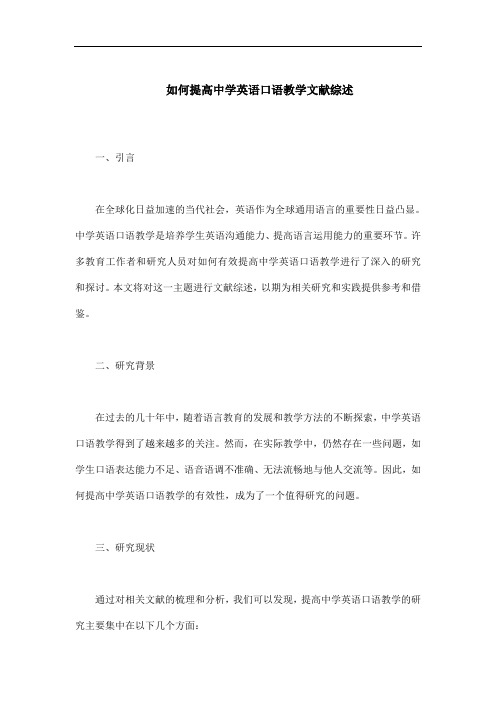
如何提高中学英语口语教学文献综述一、引言在全球化日益加速的当代社会,英语作为全球通用语言的重要性日益凸显。
中学英语口语教学是培养学生英语沟通能力、提高语言运用能力的重要环节。
许多教育工作者和研究人员对如何有效提高中学英语口语教学进行了深入的研究和探讨。
本文将对这一主题进行文献综述,以期为相关研究和实践提供参考和借鉴。
二、研究背景在过去的几十年中,随着语言教育的发展和教学方法的不断探索,中学英语口语教学得到了越来越多的关注。
然而,在实际教学中,仍然存在一些问题,如学生口语表达能力不足、语音语调不准确、无法流畅地与他人交流等。
因此,如何提高中学英语口语教学的有效性,成为了一个值得研究的问题。
三、研究现状通过对相关文献的梳理和分析,我们可以发现,提高中学英语口语教学的研究主要集中在以下几个方面:1. 教学方法与策略:许多研究者关注如何选择和运用有效的教学方法和策略,以提高学生的口语表达能力。
例如,合作学习、项目式学习、角色扮演等教学方法,都被广泛应用于英语口语教学中。
同时,一些研究还探讨了如何结合现代教育技术,如多媒体教学、网络教学等,为学生提供更为丰富的学习资源。
2. 教材与课程设计:针对口语教学的特点,一些研究者提出了具有针对性的教材和课程设计。
例如,开发适合学生水平的口语教材、增加口语实践课程、设计多样化的口语活动等。
这些措施旨在为学生提供系统化、实用性的口语训练。
3. 教师专业发展:教师素质和专业水平对英语口语教学的质量有着重要影响。
一些研究关注教师的专业发展,包括教师培训、教师角色定位、教师评价等方面。
这些研究强调教师的专业成长对于提高口语教学的重要性,并提出了多种教师发展途径。
4. 学生需求与动机:一些研究者关注学生的需求和动机,认为了解学生的需求和兴趣是提高口语教学有效性的关键。
例如,通过问卷调查、访谈等方式了解学生的需求和兴趣,然后根据这些信息调整教学策略和方法,以激发学生的学习兴趣和积极性。
(完整word版)英语语音学习策略研究文献综述(word文档良心出品)

英语语音学习策略研究文献综述一、引言语音是语言的物质外壳, 也是口语交际的载体。
顺利完成跨文化交流活动离不开语言的支撑, 要学会说任何一种语言, 首先要掌握这种语言的语音语调。
语音学习在整个英语学习中具有先导作用, 正确的语音对于听力理解至关重要, 还能帮助我们在学习词汇的过程中把单词的音, 形, 义联系起来, 甚至可以提高阅读和写作的水平。
现代英语教学强调对学生交际能力的培养。
交际能力有四个层次, 分别是语法能力, 社.会语言能力, 策略能力以及语篇能力(Canale &Swain, 1980)。
语音作为语言的必要组成部分, 也当属于语言能力的范畴(Scarcella &Oxford, 1994)。
一个人发音的好坏能够直接影响交际活动。
英语语音通常被划分为音段和超音段两大部分。
音段即元音和辅音, 超音段是话语中大于单个音段的发声单位, 重音, 节奏和语调决定话语的可理解性, 是重要的超音段特征。
英语语音学习策略指学习者为提高英语学习成效而采取的技巧, 方法或者刻意的行为或行动。
詹金斯(Jenkins)在他的实证研究中发现, 在以英语作为国际语的人际交流中, 尽管不是所有的交际失败都由发音引起, 但目前发音是引起交际失败最经常, 最难解决的原因。
因此, 语音语调在完成交际任务时承载着不可替代的基本要素的作用。
同时, 研究表明, 学习者的语音水平和他们的听力, 口语甚至阅读水平密切相关。
因此, 语音及语音教学在国内外外语教育研究中占有重要地位。
尽管如此, 语音教学同其他相关教学领域(如词汇教学, 语法教学等)的研究相比, 没有得到应有的重视(Kelly, 1967)。
语音教学是外语教学的一个重要方面, 而从学习者角度出发关注学生语音学习策略和英语语音教学的研究在国内外都很少。
二、国外研究国外的早期文献中没有专门针对语音学习策略的研究, 例如有学者于1978年调查了34名优秀的语言学习者, 在要求被试者描述自己学习经验的过程中只是从一个侧面提及了语音学习策略。
文献综述——小学英语单元整体教学设计的实践和研究

文献综述——小学英语单元整体教学设计的实践和研究随着课程改革的不断深入,越来越多的教师认识到只有遵循心理学的认知规律,依据课标要求,从单元整体角度设计英语课堂,才能提高教学效益,培养学生的综合能力。
因此,单元整体教学设计的实践和研究是未来英语教学的重要方向。
在单元整体教学中,教师需要整体把握教材中的每一个单元,合理安排教学内容,科学分解单元内的教学重点和难点,突出单元内各课时的特点,形成侧重点不同的各种课堂教学形式,促进学生语言研究的整体发展。
单元整体教学的定义是在考虑课程标准、教材和学情分析的基础上,针对一个单元,教师整体组织教学内容、设计教学方法、安排教学时间和主题作业。
此外,单元整体设计应具有整体性、相关性、阶梯性和综合性。
在小学英语教学中,经历了从传统的字词教学向语篇教学的过渡,到XXX老师关于“文本再构”、“应用性独立语段教学”理念的更替,再到基于单元整体设计教学的阶段。
但是,目前仍存在一些问题,如教师孤立地制定每节课的目标,单课时之间缺乏相关性、延续性和阶梯性等。
单元整体设计教学有利于教师实现多样化教学方式的统一,整合时间资源,培养学生从整体上把握语篇信息的能力,合理认知组块建构,促进学生语言综合运用能力的发展。
实施单元整体设计教学的原因包括理论方面和实践方面。
从理论上讲,根据“格式塔”心理学理论,研究需要在整体、部分和细节之间进行转换,单元整体教学可以帮助学生更好地理解和应用英语语言知识。
同时,单元整体教学也符合现代教育理念,强调学生的主体性和实践性。
学生的实际情况和兴趣爱好,设计出更加符合学生需求和能力的教学内容和活动。
二、整体性原则单元整体教学设计应该以语篇为核心,将听、说、读、写等语言技能有机地结合起来,形成一个完整的语言研究过程。
教师应该引导学生从整体上理解和掌握语言知识,培养学生从整体上感知和运用语言的能力。
三、循序渐进原则语言研究是一个渐进的过程,需要循序渐进地进行。
教师应该根据学生的实际情况和语言能力,逐步引导学生掌握新的语言知识和技能。
国内外英语口语教学研究综述
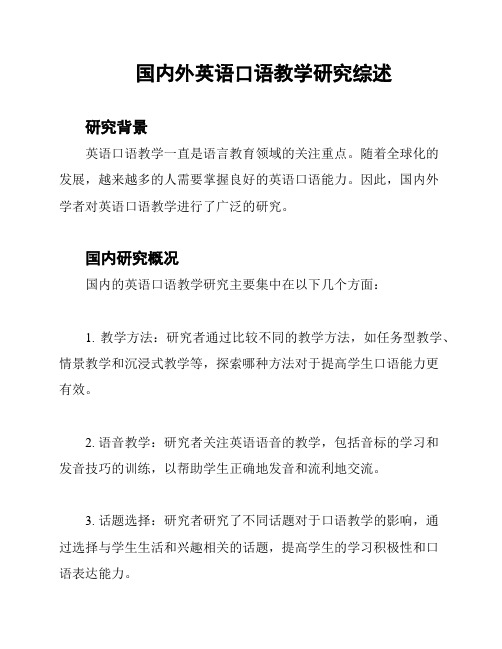
国内外英语口语教学研究综述研究背景英语口语教学一直是语言教育领域的关注重点。
随着全球化的发展,越来越多的人需要掌握良好的英语口语能力。
因此,国内外学者对英语口语教学进行了广泛的研究。
国内研究概况国内的英语口语教学研究主要集中在以下几个方面:1. 教学方法:研究者通过比较不同的教学方法,如任务型教学、情景教学和沉浸式教学等,探索哪种方法对于提高学生口语能力更有效。
2. 语音教学:研究者关注英语语音的教学,包括音标的学习和发音技巧的训练,以帮助学生正确地发音和流利地交流。
3. 话题选择:研究者研究了不同话题对于口语教学的影响,通过选择与学生生活和兴趣相关的话题,提高学生的学习积极性和口语表达能力。
4. 评估方法:研究者提出了各种评估口语能力的方法,包括面试、演讲和对话等,以便更全面地了解学生的口语水平并指导教学。
国外研究概况国外的英语口语教学研究也取得了许多重要成果:1. 社交交际能力:研究者重视培养学生的社交交际能力,通过角色扮演、讨论和小组合作等活动,培养学生的口语表达和交际能力。
2. 技术辅助教学:研究者探索了利用技术辅助教学的方法,如使用电子设备、网络资源和语音识别软件等,提高学生的口语教学效果。
3. 文化意识培养:研究者关注培养学生的跨文化交际能力,通过介绍英语国家的文化背景和实际情境,提高学生的文化意识和口语表达能力。
4. 口语与听力结合:研究者强调口语教学与听力训练的结合,通过听力材料的选择和口语实践的训练,提高学生的听说能力和语音感知能力。
总结国内外的英语口语教学研究取得了丰硕的成果,涉及教学方法、语音教学、话题选择、评估方法、社交交际能力、技术辅助教学、文化意识培养和口语与听力结合等方面。
未来的研究可以在这些基础上进一步深入探讨,以提高英语口语教学的效果和质量。
(注意:以上内容仅为示例,不可确认真实性)。
英语口语文献综述范文模板
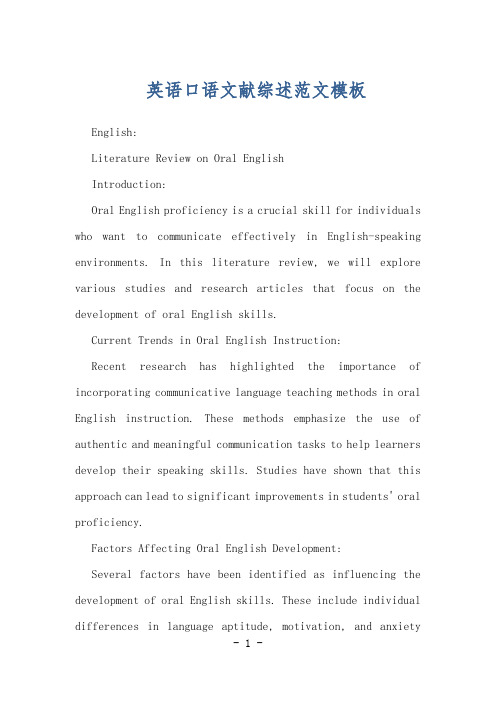
英语口语文献综述范文模板English:Literature Review on Oral EnglishIntroduction:Oral English proficiency is a crucial skill for individuals who want to communicate effectively in English-speaking environments. In this literature review, we will explore various studies and research articles that focus on the development of oral English skills.Current Trends in Oral English Instruction:Recent research has highlighted the importance of incorporating communicative language teaching methods in oral English instruction. These methods emphasize the use of authentic and meaningful communication tasks to help learners develop their speaking skills. Studies have shown that this approach can lead to significant improvements in students' oral proficiency.Factors Affecting Oral English Development:Several factors have been identified as influencing the development of oral English skills. These include individual differences in language aptitude, motivation, and anxietylevels. Research has also shown that the amount and quality of input, as well as opportunities for practice, play a crucial role in oral English development.Technology in Oral English Learning:The use of technology in language learning has become increasingly popular in recent years. Online platforms, mobile apps, and virtual reality tools can provide additional opportunities for students to practice their oral English skills outside of the classroom. Research has shown that these technological tools can be effective in enhancing students' speaking abilities.Assessment of Oral English Proficiency:Assessing oral English proficiency can be challenging, as it involves evaluating a range of skills such as fluency, accuracy, vocabulary, and pronunciation. Traditional assessment methods, such as interviews and oral exams, have limitations in terms of reliability and validity. Researchers have been exploring alternative assessment approaches, including performance-based tasks and self-assessment tools.Conclusion:In conclusion, developing oral English proficiency is essential for effective communication in English. Theliterature review has highlighted the importance of communicative language teaching methods, individual factors, technology, and assessment in oral English instruction. Future research should continue to explore innovative approaches to help learners improve their speaking skills.中文:口语英语文献综述介绍:口语英语能力对于希望在英语环境中有效交流的个人来说至关重要。
国内外英语口语教学研究综述

国内外英语口语教学研究综述1. 引言英语口语作为英语学习中至关重要的一个方面,在全球化的今天扮演着重要的角色。
国内外许多研究者对英语口语教学进行了广泛而深入的研究,本文旨在对这些研究进行综述,以期为英语口语教学提供理论支持和实践指导。
2. 国内英语口语教学研究2.1 教学方法与策略国内英语口语教学研究主要关注教学方法和策略。
许多研究者认为,任务型教学法、交际型教学法和合作学习法等教学方法能有效提高学生的英语口语能力(张丽,2010;李华,2012)。
此外,一些研究者还探讨了词汇、语法和语音等语言要素在口语教学中的重要性(王强,2015)。
2.2 课程设置与教材关于课程设置,国内研究者认为,口语课程应注重实践性和实用性,以培养学生的交际能力为目标(刘芳,2011)。
在教材方面,研究者提倡使用贴近生活、具有时代感的素材,以激发学生的学习兴趣(陈燕,2014)。
2.3 教师素质与培训国内研究者还关注英语口语教师的素质和培训。
许多研究者认为,具备良好语言素质、教学能力和跨文化交际能力的教师对英语口语教学至关重要(吴丽,2013;胡玉,2016)。
此外,研究者还提出了针对英语口语教师的培训策略,如加强师资队伍建设、开展教学研讨和交流等(周红,2017)。
3. 国际英语口语教学研究3.1 教学理念与模式国际英语口语教学研究倾向于探讨教学理念和模式。
研究者认为,交际语言教学法、全身反应法、自然法等教学理念和模式有助于提高学生的英语口语水平(Nunan,1991;Larsen-Freeman,2000)。
3.2 语言环境与跨文化交际国际研究者关注语言环境和跨文化交际在英语口语教学中的作用。
他们认为,创设真实的语言环境和培养学生的跨文化交际能力是提高英语口语的关键(Kramsch,1993;Hymes,1971)。
3.3 教学评价与测试在国际英语口语教学研究中,教学评价和测试也是一大热点。
研究者提出,应采用多元化的评价方式,如课堂表现、口语考试和自我评价等,以全面评估学生的英语口语能力(Spencer-Oatey,2006;Swan,1995)。
对中学英语口语研究的文献综述[1]
![对中学英语口语研究的文献综述[1]](https://img.taocdn.com/s3/m/93ff6ec1b14e852458fb5747.png)
对中学英语口语研究的文献综述高中英语教学的目标是培养学生的综合语言运用能力,它的形成是建立在语言技能、语言知识、情感态度、学习策略和文化意识等素养整合发展的基础上的。
(高鹏,康定民族师范高等专科学校学报【J】中学英语口语教学,第9卷第20期{总第30期},2000年6月})新的课程标准对于上述五个方面都有具体规定。
语言技能包括听、说、读、写四个方面的技能以及这四种技能的综合运用能力。
由于高考的导向,在中学教学中一度忽视了学生口语交际能力的培养。
因此,努力探索中学英语教学中培养学生口语交际能力的方法已显得相当重要了。
高中英语教学应该着重培养学生在人际交往中得体地使用英语的能力。
与书面表达和阅读理解能力相比,学生的口头交际能力普遍较低,要使学生达到新的课程标准中规定的有关“说”的要求,我们教师任重而道远。
首先我们应该认识到中学英语口语教学出现的一些问题:一、长久不不变的教学环境和模式在传统教学环境中,教学活动仅以教材、教师、教室为重心,教师习惯于套用旧的教学模式———封闭式教学,而忽略了学校与社区的关系,即忽略了学校和社区应相互依托、相互开放资源的紧密联系。
在传统的教学活动中,教师没有担负起扮演社区型、开放型角色的职责,从而使教学的重心偏重于书本知识,而与社区的“真实”活动相脱离。
这种封闭的教学环境使学生失去理论联系实际的机会,没有可供练习口语的“真实”语境,进而丧失学习的积极性,从而影响中学生英语口语能力的提高。
由于有中招、高考等考试讲究的是总分上线,而大部分又都采用笔试,其中英语作为一门语言其口试往往不做要求,这就导致教师在引导学生进行英语学习的时候对英语口语的不重视。
由此可见,在应试教育中,笔试“超重”,口试“失重”,教师大大忽略了中学生口语表达能力的培养与训练。
这一现象在那些经济欠发达、对外交流不活跃地区尤为突出。
(张克福,新乡教育学院学报【J】中学英语口语教学现状及对策研究,第18 卷第2 期,2005 年6 月)教学用书的制约也是一大因素。
英语口语教学法文献综述
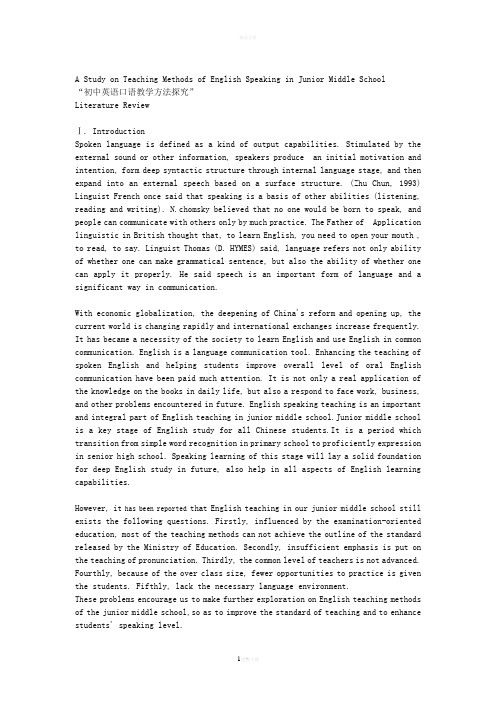
A Study on Teaching Methods of English Speaking in Junior Middle School“初中英语口语教学方法探究”Literature ReviewⅠ. IntroductionSpoken language is defined as a kind of output capabilities. Stimulated by the external sound or other information, speakers produce an initial motivation and intention, form deep syntactic structure through internal language stage, and then expand into an external speech based on a surface structure. (Zhu Chun, 1993) Linguist French once said that speaking is a basis of other abilities (listening, reading and writing). N.chomsky believed that no one would be born to speak, and people can communicate with others only by much practice. The Father of Application linguistic in British thought that, to learn English, you need to open your mouth , to read, to say. Linguist Thomas (D. HYMES) said, language refers not only ability of whether one can make grammatical sentence, but also the ability of whether one can apply it properly. He said speech is an important form of language and a significant way in communication.With economic globalization, the deepening of China's reform and opening up, the current world is changing rapidly and international exchanges increase frequently. It has became a necessity of the society to learn English and use English in common communication. English is a language communication tool. Enhancing the teaching of spoken English and helping students improve overall level of oral English communication have been paid much attention. It is not only a real application of the knowledge on the books in daily life, but also a respond to face work, business, and other problems encountered in future. English speaking teaching is an important and integral part of English teaching in junior middle school.Junior middle school is a key stage of English study for all Chinese students.It is a period which transition from simple word recognition in primary school to proficiently expression in senior high school. Speaking learning of this stage will lay a solid foundation for deep English study in future, also help in all aspects of English learning capabilities.However, it has been reported that English teaching in our junior middle school still exists the following questions. Firstly, influenced by the examination-oriented education, most of the teaching methods can not achieve the outline of the standard released by the Ministry of Education. Secondly, insufficient emphasis is put on the teaching of pronunciation. Thirdly, the common level of teachers is not advanced. Fourthly, because of the over class size, fewer opportunities to practice is given the students. Fifthly, lack the necessary language environment.These problems encourage us to make further exploration on English teaching methods of the junior middle school,so as to improve the standard of teaching and to enhance students' speaking level.The following paper reviews researches on main teaching methods of English speaking in and abroad.Ⅱ. Research status in and abroadSpeaking is one of main language output skills. American linguist Krashen put forward the Second Language Acquisition Theory in the 1970s, which attracted much attention in both linguistics field and language teaching circle. On account of the defects of Krashen's Input Hypothesis, second language acquisition researcher Merrill Swain proposed the language output assumptions in 1985. He believes that language input is important for language acquisition, but it can not make people use language accurately and fluently. According to Swain, output plays a major role in the following three aspects: 1) Noting and triggering function 2) testing the hypothesis function 3) meta-language function.Swain pointed out that, although comprehensible language input played an important role in language acquisition, learners must rely on meaningful language output to achieve accuracy and fluency of applying target language.In recent years, the English teaching in junior middle school of China has gone through much reform and the importance of teaching has been widespreadly concerned. The new English teaching textbooks or materials focus on teaching the skills of speaking. To some extent, teacher have paid a lot of attention on students' ability of oral communication. However, the rate of progress is quite slow and the results are always not pleased. Junior students' abilities of using English to express their thoughts and feelings are very limited, most remaining the level of greeting.Effected by Krashen's input hypothesis, English teaching focused on the language input. Teachers stressed students' listening, reading, ignoring the language of the output for a long time. These years, many books and research papers on teaching methods of English speaking in junior middle school have been published. They made analysis of the current situation and reform suggestions on this topic, showing that we have recognized the importance of speaking ability.The textbook" A Course in English Language Teaching" ( Edited by Wang Qiang) summarized the principles for teaching speaking and designed some speaking tasks. In the paper “Researches on Teaching Methods of English Speaking in Junior Middle School”, the author Li Shenglian summarized the current existed problems and its reasons of English speaking teaching, designed different teaching methods and procedures according to students’ levels, and introduces the exact strategies in English speaking teaching.The paper "English Teaching Researches on Oral Fluency Theory in and abroad" lists the research fruits on oral fluency of second language in home and abroad. It is of great meaning to combine them with our English teaching.Zhu Mingju published a paper named "The input and output in English Speaking Teaching". It is proposed in the paper that the input which best encourages learners' thinking in English is most desirable, but input alone cannot lead to oral English competence, and output exercises should be devised in the way that they benefit thecultivation of learners' English abilities both in carrying out speech plan and in making speech plan.The paper "Language Output Theory and Oral English Teaching"(Zhao Na) aims at investigating and expounding the effects of oral output on second language acquisition and making attempts on finding out an effective way to facilitate oral output and improve the quality of foreign language teaching of the nation wide.Ⅲ. SummaryAfter referring large amount of books and materials in and abroad, combining with language output theory and second language acquisition theory, this paper makes deep investigation, research and analysis on the circumstances and improvement strategies of English Speaking Teaching in Junior middle school. Generally speaking, china has increasingly underlined the English speaking in recent years, with a lot of constructive teaching methods proposed. English teaching in junior middle school is stepping into a new level.Ⅳ.References(1).王蔷. 英语教学法教程. 高等教育出版社,2004.1.(2).卢仁顺.“输出假设”研究对我国英语英语教学研究的启示[J].外语教学与研究,2002.4.(3).戴炜栋.构建具有中国特色的英语教学“一条龙”体系[J].外语教学与研究,2001.5.(4).Swain, M.Three functions of output in second language learning[A]. In G. Cook&B.Seidlhofer(eds.),Principle and Practice in Applied Linguistics[C].Oxford: Oxford University Press,1995.(5).朱纯. 外语教学心理学[ M ] . 上海外语教育出版社,1994, 9( 1) .(6).英语课程标准(实验稿)[M].北京:北京师范大学出版社,2002,(8).(7) Hedge, T. Teaching and Learning in the Language Classroom.上海外语教育出版社,2002.(8).黄嘉欣.初中英语口语教学探微[A].海外英语,2010.09.(9)李声莲.初中英语口语教学方法研究[J].知识经济,2010.10.(10).林铭芸.初中英语口语教学困难的成因及对策[J].广西教育,2010.23.(11).杭里.初中英语口语教学现状与策略研究[J].考试周刊,2009,40.(12).陈平文.基于国内外口语流利性理论的英语教学研究[A].外语界,2008.03.(13).卢颖.浅谈输出理论与英语口语教学[J].中国校外教育(理论),2007.04.(14).朱明炬.英语口语教学中的输入与输出[A].外语电化教学,2000.03.(15).赵娜.语言输出理论对英语口语教学的启示[A].牡丹江师范学院学报(哲学社会科学版),2009.04(16).魏军梅.输出理论和英语口语教学[A].甘肃政法成人教育学院学报,2007.06(17).胡壮麟.语言学教程.北京:北京大学出版社,2001欢迎您的下载,资料仅供参考!致力为企业和个人提供合同协议,策划案计划书,学习资料等等打造全网一站式需求。
英语口语文献综述范文模板
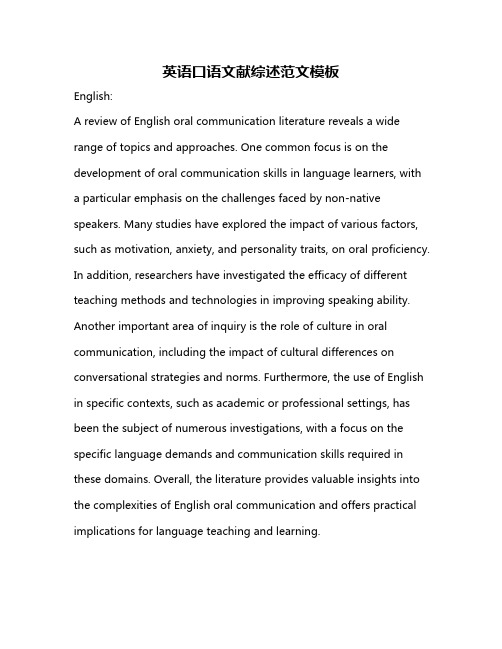
英语口语文献综述范文模板English:A review of English oral communication literature reveals a wide range of topics and approaches. One common focus is on the development of oral communication skills in language learners, with a particular emphasis on the challenges faced by non-native speakers. Many studies have explored the impact of various factors, such as motivation, anxiety, and personality traits, on oral proficiency. In addition, researchers have investigated the efficacy of different teaching methods and technologies in improving speaking ability. Another important area of inquiry is the role of culture in oral communication, including the impact of cultural differences on conversational strategies and norms. Furthermore, the use of English in specific contexts, such as academic or professional settings, has been the subject of numerous investigations, with a focus on the specific language demands and communication skills required in these domains. Overall, the literature provides valuable insights into the complexities of English oral communication and offers practical implications for language teaching and learning.中文翻译:对英语口语交际文献的综述揭示了广泛的主题和方法。
关于提高中学生口语教学的文献综述(5篇范文)
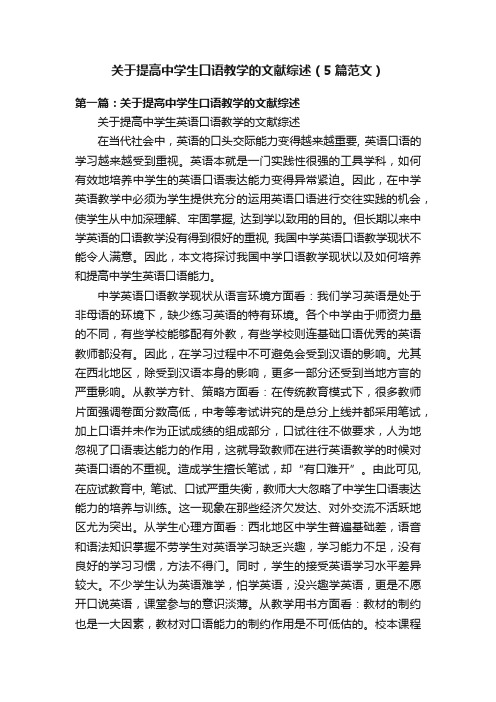
关于提高中学生口语教学的文献综述(5篇范文)第一篇:关于提高中学生口语教学的文献综述关于提高中学生英语口语教学的文献综述在当代社会中,英语的口头交际能力变得越来越重要, 英语口语的学习越来越受到重视。
英语本就是一门实践性很强的工具学科,如何有效地培养中学生的英语口语表达能力变得异常紧迫。
因此,在中学英语教学中必须为学生提供充分的运用英语口语进行交往实践的机会,使学生从中加深理解、牢固掌握, 达到学以致用的目的。
但长期以来中学英语的口语教学没有得到很好的重视, 我国中学英语口语教学现状不能令人满意。
因此,本文将探讨我国中学口语教学现状以及如何培养和提高中学生英语口语能力。
中学英语口语教学现状从语言环境方面看:我们学习英语是处于非母语的环境下,缺少练习英语的特有环境。
各个中学由于师资力量的不同,有些学校能够配有外教,有些学校则连基础口语优秀的英语教师都没有。
因此,在学习过程中不可避免会受到汉语的影响。
尤其在西北地区,除受到汉语本身的影响,更多一部分还受到当地方言的严重影响。
从教学方针、策略方面看:在传统教育模式下,很多教师片面强调卷面分数高低,中考等考试讲究的是总分上线并都采用笔试,加上口语并未作为正试成绩的组成部分,口试往往不做要求,人为地忽视了口语表达能力的作用,这就导致教师在进行英语教学的时候对英语口语的不重视。
造成学生擅长笔试,却“有口难开”。
由此可见, 在应试教育中, 笔试、口试严重失衡,教师大大忽略了中学生口语表达能力的培养与训练。
这一现象在那些经济欠发达、对外交流不活跃地区尤为突出。
从学生心理方面看:西北地区中学生普遍基础差,语音和语法知识掌握不劳学生对英语学习缺乏兴趣,学习能力不足,没有良好的学习习惯,方法不得门。
同时,学生的接受英语学习水平差异较大。
不少学生认为英语难学,怕学英语,没兴趣学英语,更是不愿开口说英语,课堂参与的意识淡薄。
从教学用书方面看:教材的制约也是一大因素,教材对口语能力的制约作用是不可低估的。
外语焦虑对大学生英语口语影响的原因及对策探讨文献综述

外语焦虑对大学生英语口语影响的原因及对策探讨经济全球化的发展使跨语言、跨文化的交流活动空前频繁,社会对人才的外语水平提出了更高的要求。
虽然我国曾经学过或正在学习英语的人比美国人口还多,但是真正能用英语交流的人却寥寥无几。
他们辛苦耕耘英语十几年,付出了很大的努力,绝大多数人却还在“聋哑英语”的怪圈中苦苦挣扎,其口语水平远远达不到时代的要求。
如何提高英语口语水平,突破口语交流的障碍,是众多教师和研究者们一直不断尝试和潜心探索的问题。
而Arnold&Brown(1991)调查研究认为,影响学生口语水平的主要原因在于普遍存在学生当中的心理障碍,这些障碍主要有:焦虑感、自信心、动机、情感兴趣等,经过科学的方法研究表明,影响口语最大的因素是焦虑感。
焦虑作为一个情感变量是属于心理情感的一种主要表现形式。
焦虑是变态情绪之一,又称心理异常,一般认为焦虑是指个体对于预期不能达到目标或者不能克服障碍的威胁,其自尊心与自信心受挫,或失败感和内疚感增加而形成的紧张不安、带有恐惧感的情绪状态。
在心理情感和英语口语关系的国内外研究中都很流行并取得了不凡的成就。
国外的研究成果有Krashen(1985)的情感过滤假说。
他认为,情感过滤控制着学习者接触到的输入的量,同时控制着输入转化为吸入的量。
动机强烈、焦虑弱和充满自信的学习者过滤就低,因此获得的输入量就大;反之,缺少动机、自信,并伴有焦虑的学习者过滤就高,因此获得的输入量也就大大减少。
党彩平(2005)在其研究中提到:“焦虑研究起源于…存在主义‟哲学领域,最早提出焦虑理论的人是哲学家克尔凯郭尔(党彩平2005)。
他在《恐惧的概念》一书中指出,焦虑是人在面对自由选择时因无法预料新路彼岸潜藏的危险而形成的非理性的体验。
”然而焦虑研究真正出现繁荣却来自于认知理论的发展。
Scovel(1978)认为焦虑是一种情感状态,一种仅仅与某一对象间接相关的畏惧或模糊恐惧感。
Young(1992)则认为焦虑是人类心理活动的一种心理状态和外在表现形式,这种心理状态常是人们无法达到或实现预期目的的一种心理表现。
英语教学法文献综述范文模板例文
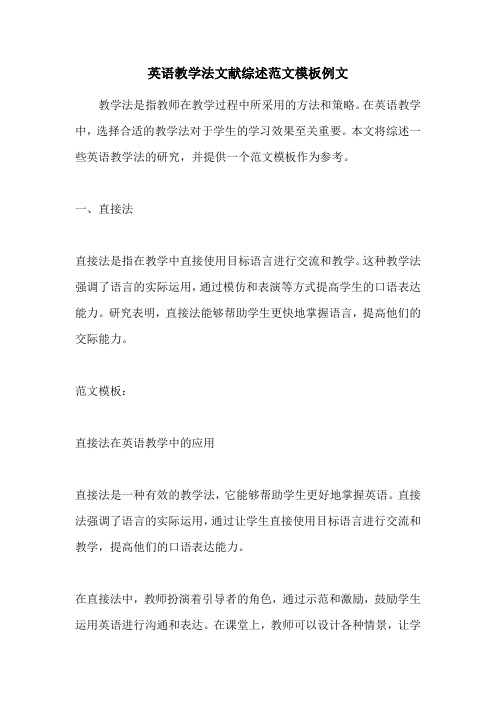
英语教学法文献综述范文模板例文教学法是指教师在教学过程中所采用的方法和策略。
在英语教学中,选择合适的教学法对于学生的学习效果至关重要。
本文将综述一些英语教学法的研究,并提供一个范文模板作为参考。
一、直接法直接法是指在教学中直接使用目标语言进行交流和教学。
这种教学法强调了语言的实际运用,通过模仿和表演等方式提高学生的口语表达能力。
研究表明,直接法能够帮助学生更快地掌握语言,提高他们的交际能力。
范文模板:直接法在英语教学中的应用直接法是一种有效的教学法,它能够帮助学生更好地掌握英语。
直接法强调了语言的实际运用,通过让学生直接使用目标语言进行交流和教学,提高他们的口语表达能力。
在直接法中,教师扮演着引导者的角色,通过示范和激励,鼓励学生运用英语进行沟通和表达。
在课堂上,教师可以设计各种情景,让学生在实际交流中学习语言。
比如,教师可以组织角色扮演活动,让学生扮演不同的角色,使用英语进行对话。
这种方式可以激发学生的兴趣,提高他们的口语表达能力。
研究表明,直接法对于学生的学习效果有积极的影响。
通过直接使用目标语言进行交流,学生能够更快地掌握语言。
此外,直接法还可以提高学生的交际能力,培养他们的语言思维能力。
总之,直接法是一种有效的英语教学法。
通过直接使用目标语言进行交流,学生可以更好地掌握英语。
教师在教学中可以运用各种情景,激发学生的兴趣,提高他们的口语表达能力。
因此,在英语教学中应该广泛采用直接法。
二、交际法交际法是指在教学中注重学生的交际能力培养。
这种教学法强调学生的实际应用能力,通过情境交际和真实对话等方式提高学生的语言交际能力。
研究表明,交际法能够激发学生的学习兴趣,提高他们的语言运用能力。
范文模板:交际法在英语教学中的应用交际法是一种有效的教学法,它能够帮助学生更好地掌握英语。
交际法强调了学生的交际能力培养,通过情境交际和真实对话等方式提高学生的语言交际能力。
在交际法中,教师注重创造一个真实的语言环境,激发学生的学习兴趣。
近五年大学英语口语教学研究文献综述和分析最新教育资料
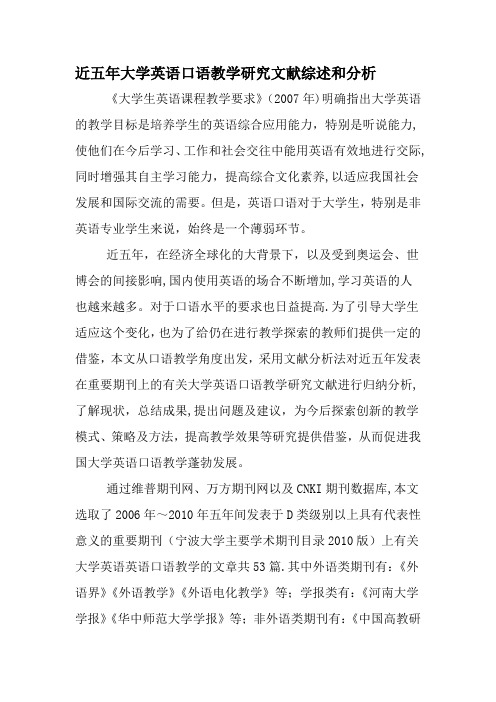
近五年大学英语口语教学研究文献综述和分析《大学生英语课程教学要求》(2007年)明确指出大学英语的教学目标是培养学生的英语综合应用能力,特别是听说能力,使他们在今后学习、工作和社会交往中能用英语有效地进行交际,同时增强其自主学习能力,提高综合文化素养,以适应我国社会发展和国际交流的需要。
但是,英语口语对于大学生,特别是非英语专业学生来说,始终是一个薄弱环节。
近五年,在经济全球化的大背景下,以及受到奥运会、世博会的间接影响,国内使用英语的场合不断增加,学习英语的人也越来越多。
对于口语水平的要求也日益提高.为了引导大学生适应这个变化,也为了给仍在进行教学探索的教师们提供一定的借鉴,本文从口语教学角度出发,采用文献分析法对近五年发表在重要期刊上的有关大学英语口语教学研究文献进行归纳分析,了解现状,总结成果,提出问题及建议,为今后探索创新的教学模式、策略及方法,提高教学效果等研究提供借鉴,从而促进我国大学英语口语教学蓬勃发展。
通过维普期刊网、万方期刊网以及CNKI期刊数据库,本文选取了2006年~2010年五年间发表于D类级别以上具有代表性意义的重要期刊(宁波大学主要学术期刊目录2010版)上有关大学英语英语口语教学的文章共53篇.其中外语类期刊有:《外语界》《外语教学》《外语电化教学》等;学报类有:《河南大学学报》《华中师范大学学报》等;非外语类期刊有:《中国高教研究》《中国成人教育》等。
这些刊物在各个研究领域都有良好的代表性。
一、大学英语口语教学研究现状1.基本研究趋势在这五年中,我国对大学生英语口语教学的研究有呈下滑后上升的趋势(见图1)。
总体来看,2006至2010这五年间,研究者对大学生英语口语教学的研究没有间断,每年都有一定数量的研究文章在各类刊物上发表.但在2009年相关论文仅发表4篇,相比前三年,数量有明显下滑,而到2010年又上升至9篇。
■图12006—2010年重要刊物中有关大学英语口语教学研究文章数量趋势图2。
英语口语教学法文献综述
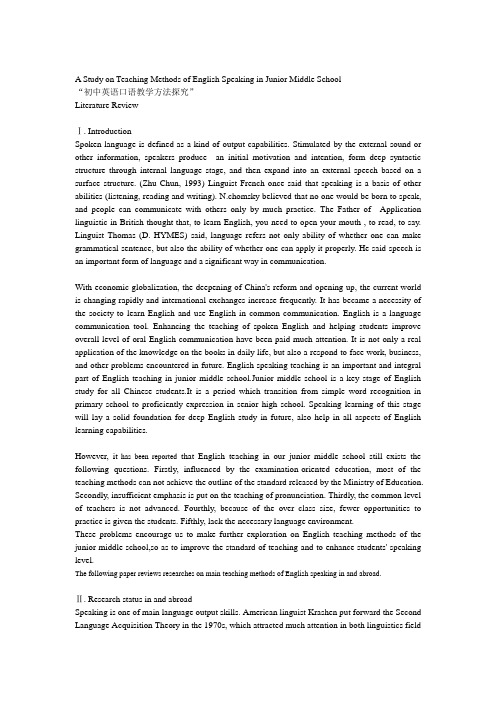
A Study on Teaching Methods of English Speaking in Junior Middle School“初中英语口语教学方法探究”Literature ReviewⅠ. IntroductionSpoken language is defined as a kind of output capabilities. Stimulated by the external sound or other information, speakers produce an initial motivation and intention, form deep syntactic structure through internal language stage, and then expand into an external speech based on a surface structure. (Zhu Chun, 1993) Linguist French once said that speaking is a basis of other abilities (listening, reading and writing). N.chomsky believed that no one would be born to speak, and people can communicate with others only by much practice. The Father of Application linguistic in British thought that, to learn English, you need to open your mouth , to read, to say. Linguist Thomas (D. HYMES) said, language refers not only ability of whether one can make grammatical sentence, but also the ability of whether one can apply it properly. He said speech is an important form of language and a significant way in communication.With economic globalization, the deepening of China's reform and opening up, the current world is changing rapidly and international exchanges increase frequently. It has became a necessity of the society to learn English and use English in common communication. English is a language communication tool. Enhancing the teaching of spoken English and helping students improve overall level of oral English communication have been paid much attention. It is not only a real application of the knowledge on the books in daily life, but also a respond to face work, business, and other problems encountered in future. English speaking teaching is an important and integral part of English teaching in junior middle school.Junior middle school is a key stage of English study for all Chinese students.It is a period which transition from simple word recognition in primary school to proficiently expression in senior high school. Speaking learning of this stage will lay a solid foundation for deep English study in future, also help in all aspects of English learning capabilities.However, it has been reported that English teaching in our junior middle school still exists the following questions. Firstly, influenced by the examination-oriented education, most of the teaching methods can not achieve the outline of the standard released by the Ministry of Education. Secondly, insufficient emphasis is put on the teaching of pronunciation. Thirdly, the common level of teachers is not advanced. Fourthly, because of the over class size, fewer opportunities to practice is given the students. Fifthly, lack the necessary language environment.These problems encourage us to make further exploration on English teaching methods of the junior middle school,so as to improve the standard of teaching and to enhance students' speaking level.The following paper reviews researches on main teaching methods of English speaking in and abroad.Ⅱ. Research status in and abroadSpeaking is one of main language output skills. American linguist Krashen put forward the Second Language Acquisition Theory in the 1970s, which attracted much attention in both linguistics fieldand language teaching circle. On account of the defects of Krashen's Input Hypothesis, second language acquisition researcher Merrill Swain proposed the language output assumptions in 1985. He believes that language input is important for language acquisition, but it can not make people use language accurately and fluently. According to Swain, output plays a major role in the following three aspects: 1) Noting and triggering function 2) testing the hypothesis function 3) meta-language function.Swain pointed out that, although comprehensible language input played an important role in language acquisition, learners must rely on meaningful language output to achieve accuracy and fluency of applying target language.In recent years, the English teaching in junior middle school of China has gone through much reform and the importance of teaching has been widespreadly concerned. The new English teaching textbooks or materials focus on teaching the skills of speaking. To some extent, teacher have paid a lot of attention on students' ability of oral communication. However, the rate of progress is quite slow and the results are always not pleased. Junior students' abilities of using English to express their thoughts and feelings are very limited, most remaining the level of greeting.Effected by Krashen's input hypothesis, English teaching focused on the language input. Teachers stressed students' listening, reading, ignoring the language of the output for a long time. These years, many books and research papers on teaching methods of English speaking in junior middle school have been published. They made analysis of the current situation and reform suggestions on this topic, showing that we have recognized the importance of speaking ability.The textbook" A Course in English Language Teaching" ( Edited by Wang Qiang) summarized the principles for teaching speaking and designed some speaking tasks.In the paper “Researches on Teaching Methods of English Speaking in Junior Middle School”, the author Li Shenglian summarized the current existed problems and its reasons of English speaking teaching, designed different teaching methods and procedures according to students’ levels, and introduces the exact strategies in English speaking teaching.The paper "English Teaching Researches on Oral Fluency Theory in and abroad" lists the research fruits on oral fluency of second language in home and abroad. It is of great meaning to combine them with our English teaching.Zhu Mingju published a paper named "The input and output in English Speaking Teaching". It is proposed in the paper that the input which best encourages learners' thinking in English is most desirable, but input alone cannot lead to oral English competence, and output exercises should be devised in the way that they benefit the cultivation of learners' English abilities both in carrying out speech plan and in making speech plan.The paper "Language Output Theory and Oral English Teaching"(Zhao Na) aims at investigating and expounding the effects of oral output on second language acquisition and making attempts on finding out an effective way to facilitate oral output and improve the quality of foreign language teaching of the nation wide.Ⅲ. SummaryAfter referring large amount of books and materials in and abroad, combining with language output theory and second language acquisition theory, this paper makes deep investigation,research and analysis on the circumstances and improvement strategies of English Speaking Teaching in Junior middle school. Generally speaking, china has increasingly underlined the English speaking in recent years, with a lot of constructive teaching methods proposed. English teaching in junior middle school is stepping into a new level.Ⅳ.References(1).王蔷. 英语教学法教程. 高等教育出版社,2004.1.(2).卢仁顺.“输出假设”研究对我国英语英语教学研究的启示[J].外语教学与研究,2002.4.(3).戴炜栋.构建具有中国特色的英语教学“一条龙”体系[J].外语教学与研究,2001.5.(4).Swain, M.Three functions of output in second language learning[A]. In G. Cook&B.Seidlhofer(eds.),Principle and Practice in Applied Linguistics[C].Oxford: Oxford University Press,1995.(5).朱纯. 外语教学心理学[ M ] . 上海外语教育出版社,1994, 9( 1) .(6).英语课程标准(实验稿)[M].北京:北京师范大学出版社,2002,(8).(7) Hedge, T. Teaching and Learning in the Language Classroom.上海外语教育出版社,2002.(8).黄嘉欣.初中英语口语教学探微[A].海外英语,2010.09.(9)李声莲.初中英语口语教学方法研究[J].知识经济,2010.10.(10).林铭芸.初中英语口语教学困难的成因及对策[J].广西教育,2010.23.(11).杭里.初中英语口语教学现状与策略研究[J].考试周刊,2009,40.(12).陈平文.基于国内外口语流利性理论的英语教学研究[A].外语界,2008.03.(13).卢颖.浅谈输出理论与英语口语教学[J].中国校外教育(理论),2007.04.(14).朱明炬.英语口语教学中的输入与输出[A].外语电化教学,2000.03.(15).赵娜.语言输出理论对英语口语教学的启示[A].牡丹江师范学院学报(哲学社会科学版),2009.04(16).魏军梅.输出理论和英语口语教学[A].甘肃政法成人教育学院学报,2007.06(17).胡壮麟.语言学教程.北京:北京大学出版社,2001。
对话教学研究文献综述

对话教学研究文献综述对话教学是一种以对话为基础的教学方式,它认为学生的参与是教学的核心,通过对话的过程可以帮助学生掌握知识、培养思维能力、提高沟通能力。
下面是一些有关对话教学的研究文献的综述:「A review of research on task-based language teaching」(《任务型语言教学研究综述》),这篇文章对任务型语言教学进行了系统的综述,探讨了任务型语言教学的理论基础、教学过程、教学效果以及在不同语言环境下的应用。
「The impact of pair work on L2 oral proficiency: A meta-analysis」(《成对工作对第二语言口语水平的影响:荟萃分析》),这篇文章通过荟萃分析的方法,对成对工作对学生的第二语言口语水平的影响进行了综述。
「The effects of dialogue journal writing on second language learning: A meta-analysis」(《对话日记写作对第二语言学习的影响:荟萃分析》),这篇文章通过荟萃分析的方法,对对话日记写作对学生的第二语言学习的影响进行了综述。
「The effects of collaborative dialogue on L2 vocabulary learning: A meta-analysis」(《协作对话对第二语言词汇学习的影响:荟萃分析》),这篇文章通过荟萃分析的方法,对协作对话对学生的第二语言词汇学习的影响进行了综述。
「The effectiveness of interaction in second language teaching: A meta-analysis」(《交互在第二语言教学中的有效性:荟萃分析》),这篇文章通过荟萃分析的方法,对交互在第二语言教学中的有效性进行了综述。
这些文献提供了对话教学的理论依据和实证研究,为教师在教学实践中更好地运用对话教学提供了参考。
- 1、下载文档前请自行甄别文档内容的完整性,平台不提供额外的编辑、内容补充、找答案等附加服务。
- 2、"仅部分预览"的文档,不可在线预览部分如存在完整性等问题,可反馈申请退款(可完整预览的文档不适用该条件!)。
- 3、如文档侵犯您的权益,请联系客服反馈,我们会尽快为您处理(人工客服工作时间:9:00-18:30)。
A Study on Teaching Methods of English Speaking in Junior Middle School“初中英语口语教学方法探究”Literature ReviewⅠ. IntroductionSpoken language is defined as a kind of output capabilities. Stimulated by the external sound or other information, speakers produce an initial motivation and intention, form deep syntactic structure through internal language stage, and then expand into an external speech based on a surface structure. (Zhu Chun, 1993) Linguist French once said that speaking is a basis of other abilities (listening, reading and writing). N.chomsky believed that no one would be born to speak, and people can communicate with others only by much practice. The Father of Application linguistic in British thought that, to learn English, you need to open your mouth , to read, to say. Linguist Thomas (D. HYMES) said, language refers not only ability of whether one can make grammatical sentence, but also the ability of whether one can apply it properly. He said speech is an important form of language and a significant way in communication.With economic globalization, the deepening of China's reform and opening up, the current world is changing rapidly and international exchanges increase frequently. It has became a necessity of the society to learn English and use English in common communication. English is a language communication tool. Enhancing the teaching of spoken English and helping students improve overall level of oral English communication have been paid much attention. It is not only a real application of the knowledge on the books in daily life, but also a respond to face work, business, and other problems encountered in future. English speaking teaching is an important and integral part of English teaching in junior middle school.Junior middle school is a key stage of English study for all Chinese students.It is a period which transition from simple word recognition in primary school to proficiently expression in senior high school. Speaking learning of this stage will lay a solid foundation for deep English study in future, also help in all aspects of English learning capabilities.However, it has been reported that English teaching in our junior middle school still exists the following questions. Firstly, influenced by the examination-oriented education, most of the teaching methods can not achieve the outline of the standard released by the Ministry of Education. Secondly, insufficient emphasis is put on the teaching of pronunciation. Thirdly, the common level of teachers is not advanced. Fourthly, because of the over class size, fewer opportunities to practice is given the students. Fifthly, lack the necessary language environment.These problems encourage us to make further exploration on English teaching methods of the junior middle school,so as to improve the standard of teaching and to enhance students' speaking level.The following paper reviews researches on main teaching methods of English speaking in and abroad.Ⅱ. Research status in and abroadSpeaking is one of main language output skills. American linguist Krashen put forward the Second Language Acquisition Theory in the 1970s, which attracted much attention in both linguistics fieldand language teaching circle. On account of the defects of Krashen's Input Hypothesis, second language acquisition researcher Merrill Swain proposed the language output assumptions in 1985. He believes that language input is important for language acquisition, but it can not make people use language accurately and fluently. According to Swain, output plays a major role in the following three aspects: 1) Noting and triggering function 2) testing the hypothesis function 3) meta-language function.Swain pointed out that, although comprehensible language input played an important role in language acquisition, learners must rely on meaningful language output to achieve accuracy and fluency of applying target language.In recent years, the English teaching in junior middle school of China has gone through much reform and the importance of teaching has been widespreadly concerned. The new English teaching textbooks or materials focus on teaching the skills of speaking. To some extent, teacher have paid a lot of attention on students' ability of oral communication. However, the rate of progress is quite slow and the results are always not pleased. Junior students' abilities of using English to express their thoughts and feelings are very limited, most remaining the level of greeting.Effected by Krashen's input hypothesis, English teaching focused on the language input. Teachers stressed students' listening, reading, ignoring the language of the output for a long time. These years, many books and research papers on teaching methods of English speaking in junior middle school have been published. They made analysis of the current situation and reform suggestions on this topic, showing that we have recognized the importance of speaking ability.The textbook" A Course in English Language Teaching" ( Edited by Wang Qiang) summarized the principles for teaching speaking and designed some speaking tasks.In the paper “Researches on Teaching Methods of English Speaking in Junior Middle School”, the author Li Shenglian summarized the current existed problems and its reasons of English speaking teaching, designed different teaching methods and procedures according to students’ levels, and introduces the exact strategies in English speaking teaching.The paper "English Teaching Researches on Oral Fluency Theory in and abroad" lists the research fruits on oral fluency of second language in home and abroad. It is of great meaning to combine them with our English teaching.Zhu Mingju published a paper named "The input and output in English Speaking Teaching". It is proposed in the paper that the input which best encourages learners' thinking in English is most desirable, but input alone cannot lead to oral English competence, and output exercises should be devised in the way that they benefit the cultivation of learners' English abilities both in carrying out speech plan and in making speech plan.The paper "Language Output Theory and Oral English Teaching"(Zhao Na) aims at investigating and expounding the effects of oral output on second language acquisition and making attempts on finding out an effective way to facilitate oral output and improve the quality of foreign language teaching of the nation wide.Ⅲ. SummaryAfter referring large amount of books and materials in and abroad, combining with language output theory and second language acquisition theory, this paper makes deep investigation,research and analysis on the circumstances and improvement strategies of English Speaking Teaching in Junior middle school. Generally speaking, china has increasingly underlined the English speaking in recent years, with a lot of constructive teaching methods proposed. English teaching in junior middle school is stepping into a new level.Ⅳ.References(1).王蔷. 英语教学法教程. 高等教育出版社,2004.1.(2).卢仁顺.“输出假设”研究对我国英语英语教学研究的启示[J].外语教学与研究,2002.4.(3).戴炜栋.构建具有中国特色的英语教学“一条龙”体系[J].外语教学与研究,2001.5.(4).Swain, M.Three functions of output in second language learning[A]. In G. Cook&B.Seidlhofer(eds.),Principle and Practice in Applied Linguistics[C].Oxford: Oxford University Press,1995.(5).朱纯. 外语教学心理学[ M ] . 上海外语教育出版社,1994, 9( 1) .(6).英语课程标准(实验稿)[M].北京:北京师范大学出版社,2002,(8).(7) Hedge, T. Teaching and Learning in the Language Classroom.上海外语教育出版社,2002.(8).黄嘉欣.初中英语口语教学探微[A].海外英语,2010.09.(9)李声莲.初中英语口语教学方法研究[J].知识经济,2010.10.(10).林铭芸.初中英语口语教学困难的成因及对策[J].广西教育,2010.23.(11).杭里.初中英语口语教学现状与策略研究[J].考试周刊,2009,40.(12).陈平文.基于国内外口语流利性理论的英语教学研究[A].外语界,2008.03.(13).卢颖.浅谈输出理论与英语口语教学[J].中国校外教育(理论),2007.04.(14).朱明炬.英语口语教学中的输入与输出[A].外语电化教学,2000.03.(15).赵娜.语言输出理论对英语口语教学的启示[A].牡丹江师范学院学报(哲学社会科学版),2009.04(16).魏军梅.输出理论和英语口语教学[A].甘肃政法成人教育学院学报,2007.06(17).胡壮麟.语言学教程.北京:北京大学出版社,2001。
